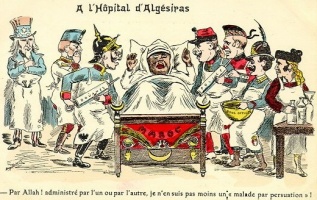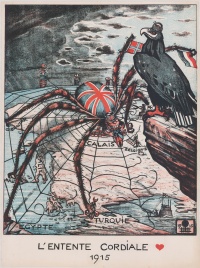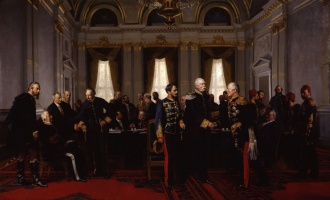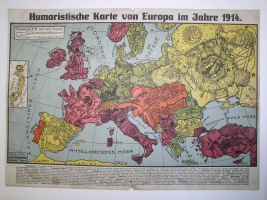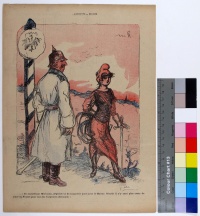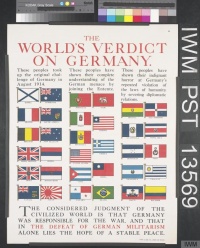Introduction: Alliances and Great Power relations in Europe, 1815-1871↑
Alliances were nothing new to international relations in modern Europe. The patterns of cooperation in the first half of the 18th century had become so familiar that switching strategic partners in preparation for the Seven Years War was dubbed as “renversement des alliances”. However, with religious and ideological issues only of marginal relevance to the cabinets of Europe, war-time alliances could be overturned quite easily. The French Revolutionary Wars (1792-1802) and Napoleonic Wars (1803-1815) put Great Britain and France in the role of perennial adversaries, both of them forging alliances with other powers if useful and possible. Paul W. Schroeder has argued that the anti-Napoleonic coalition of 1813-1814 proved to be a turning point in international relations, because the four major coalition partners - Great Britain, Russia, Austria, and Prussia - decided to put their alliance on a peace footing after the end of war in 1814 and the Vienna Settlement of 1815. The Quadruple Alliance was meant to guarantee the peace of Europe by keeping a watchful eye on France and to cooperate closely to thwart any threat to international stability on the continent, while the Holy Alliance (originally consisting of Russia, Austria and Prussia) added glamorous rhetoric to this idea. According to Schroeder, traditional balance of power policy gave way to a collective effort among the Great Powers to defend the rights and mutual obligations of all sovereign states, big or small. With France co-opted in 1818, the five Great Powers became known as the Pentarchy. The Pentarchy discussed problems related to the situation of smaller states and decided on solutions to them, a de-facto privilege of the Great Powers in a Europe of sovereign states with different level of strategic clout. Although conflicts among the Great Powers would set limits to their close cooperation in the following decades, the Concert of Europe was still at play in the debates about Balkan crises in the years and months prior to the outbreak of war in 1914.[1]
At its heyday, in the first years after the Congress of Vienna, the new consensus among the Great Powers was strong enough to make separate alliance treaties between some of them seem irrelevant. In the 1820s, with disputes over the future of Spain and her former colonies in Latin America and divergent intentions in the Eastern Question, Great Power relations were transformed. New alliances were forged between Britain and France and between the conservative monarchies of Russia, Prussia, and Austria. The latter was perceived as a bulwark anti-revolutionary policy, the former as a cooperation of more liberal-minded cabinets. With regard to the decline of the Ottoman Empire and its geopolitical consequences, different patterns of alignment emerged in 1840. It was this Eastern Question that sparked the first war between Europe’s Great Powers after the defeat of Napoleon I, Emperor of the French (1769-1821). His nephew, Napoleon III, Emperor of the French (1808-1873), was instrumental in the formation of an anti-Russian war coalition in 1853-1854. The Crimean War was a decisive blow to the Vienna Settlement, although the peace treaty of Paris in 1856 reiterated the idea of a Concert of Europe. It left Russia reeling from defeat and encouraged further revision of the international system. Alliances became important tools in the ensuing transformation of Europe. Secret treaties between France and Sardinia and Italy and Prussia, respectively, were crucial in the preparation for the wars of 1859 and 1866, and Prussia’s treaties with the southern German states came to bear in 1870-1871. The so-called Wars of Italian Independence and of German Unification changed the map of Europe by creating new nation states. They also left the Habsburg Monarchy and France in a much weaker position. The creation of Germany under Prussian leadership and the annexation of Alsace-Lorraine was the most obvious shift in the balance of power.[2]
Dual Alliance and Triple Alliance↑
With the creation of nation states in Germany and Italy completed, 1871 marked a turning point in the development of Europe’s international order. In a series of three victorious wars, Prussia had forged the economically and militarily strong German Empire, which now held a particularly powerful position on the continent. After a crisis in the mid-1870s, German Chancellor Otto von Bismarck (1815-1898) settled on a course of securing the empire’s position by isolating France and engaging with the other Great Powers, in particular Austria-Hungary and Russia. Ever the skillful diplomat, Bismarck was able to achieve this much, but he left a difficult legacy to his successors after his dismissal in 1890. It turned out to be particularly difficult to maintain close ties with Russia without encouraging St. Petersburg to wage a policy of expansion on the Balkans. Several times, Bismarck tried to build on the traditional pattern of anti-revolutionary cooperation between the monarchies of the Romanovs, the Hohenzollern, and the Habsburgs. The Three Emperors’ League was agreed upon in a treaty between Alexander II, Emperor of Russia (1818-1881), Wilhelm I, German Emperor (1797-1888), and Francis Joseph I, Emperor of Austria (1830-1916) in September 1873. It evoked the spirit of the Holy Alliance, but would not survive the clash of interests between Austria-Hungary and Russia that developed just a few years later over the expansion of Russian influence in South East Europe and the creation of a Greater Bulgaria in the 1878 San Stefano peace treaty between Russia and the Ottoman Empire.[3]
The Balkan Crisis of the 1870s and the Congress of Berlin in 1878, at which Bismarck did not save Russia from international pressure to give up on the project of Greater Bulgaria, rattled the foundations of the cooperation between the three conservative monarchies of the Hohenzollerns, the Romanovs, and the Habsburgs. An Austrian initiative led to the so-called Dual Alliance, a defensive alliance between the German Empire and the Habsburg Monarchy. The secret alliance treaty of 7 October 1879 assured Austria-Hungary of German military assistance in case of a Russian attack on the Dual Monarchy. Austria-Hungary also committed herself to come to the rescue of her ally in case of a Russian attack on Germany, a highly unlikely scenario. The Germans would get little in return, since the Austrians were under no obligation to come to their ally’s rescue in the case of a French attack on the German Empire. Benevolent neutrality was all they had to promise, unless France would be fighting alongside Russia.[4]
Bismarck wanted to shield the Habsburg Monarchy from Russian aggression and to get a say in Austria’s foreign policy. Without German consent, any diplomatic or military action taken by the Austrians that led to Russian countermeasures might jeopardize Germany’s commitment to the alliance. The casus foederis, Bismarck made clear in the 1880s, would only be triggered if Austria’s actions were first cleared with Berlin and the subsequent Russian attack labeled “unprovoked”. In this way, Bismarck avoided a situation in which the weaker of the allies would be able to steer the stronger one towards war. The German chancellor was not only trying to commit Vienna to close coordination of its Balkan policy with Berlin; he also hoped to make the Dual Alliance the cornerstone of cooperation in other fields and to tie the Habsburg Monarchy to the German Reich in a way reminiscent of the Holy Roman Empire. Gyula Andrássy (1860-1929), Bismarck’s opponent, refused to have the treaty ratified by parliaments, and it would be kept secret until 1889, when Bismarck published it to deter Russia at the height of the Dual Crisis.[5]
Nevertheless, the Dual Alliance was not considered to be just another international treaty, but rather the foundation and symbol of a special relationship between the German Empire and the Dual Monarchy. The very basis of Austro-Hungarian dualism, the dominating influence of the Germans in Austria and the Magyars in Hungary, was seen as non-negotiable in Berlin, in order to keep Slav aspirations in Europe at bay. German diplomats and politicians would not shy away from telling their counterparts so, but up to a point, the underlying Teutonic, anti-Slav rhetoric also limited Germany’s freedom of action. The term “Nibelungentreue”, applied to German-Austrian relations by Chancellor Bernhard von Bülow (1849-1929) in 1909, put a name to the cultural underpinnings of the Dual Alliance that had to be accounted for by German politicians. With Italy staying out of the fray in 1914, the Dual Alliance became the nucleus of what would be called the war coalition of the Central Powers.[6]
The Dual Alliance would be renewed on a regular basis and still existed in 1914, but by that time, most contemporaries had begun to use the term Triple Alliance when they were talking about Germany’s and Austria-Hungary’s most important alliance treaty. As in the case of Germany, the creation of Italy as a nation state had come at the expense of the Habsburg Monarchy. But unlike Germany, where the idea of uniting the German-speaking parts of Austria with the German Empire enjoyed almost no support, the vision of an Italy that included the Italian-speaking regions of the Habsburg Monarchy held considerable appeal for the Italian elites. In addition, the aspiring new – and still not very strong – Great Power Italy was vying with Austria-Hungary for control in the Adriatic. The potential for conflict between both powers notwithstanding, Italy had reasons to cover her back while she was striving for colonial expansion in the Mediterranean. With France blocking Italy’s path by seizing Tunisia in 1881, the government in Rome had to turn to Vienna and Berlin in search of protection in case of future colonial conflicts.
In the Triple Alliance Treaty of 20 May 1882 between Germany, Austria-Hungary and Italy, Italy and Germany were promised military support in case of an unprovoked attack by France. If two or more of the Great Powers attacked one of the three alliance partners, the other two would also be required to intervene by force. If only one Great Power forced one of the allies to resort to war, the others were obliged to keep a neutral stance, unless they decided to help militarily.[7] Romania, whose king was a member of the Hohenzollern dynasty, acceded in October 1883.[8] The treaty was meant to be secret, but in 1883 an Italian politician made the existence of the alliance public. Its text would be kept secret, as would the articles that were to be added in later years when the treaty was up for renewal. From an Italian point of view, her allies’ pledge of support in case of a war with France was essential; for Bismarck, the alliance helped to keep France isolated and would, in combination with the Dual Alliance, allay Austrian fears of Russian dominance in South East Europe. Vienna’s intention to preserve the status quo on the Balkan peninsula resonated with British priorities in the Eastern Mediterranean. It was also in Berlin’s interest to see the emergence of an alignment of Italy, Great Britain, and Austria-Hungary. This was formalized in a set of agreements brokered by Bismarck that culminated in a treaty between Great Britain and Italy in February 1887, with Austria-Hungary in March 1887 and with Spain in May 1887. The so-called Mediterranean Entente defused conflicts between Austria-Hungary and Italy, but most importantly, it contained Russia in the Eastern Mediterranean quite successfully in the late 1880s and early 1890s.
In 1891, when the Triple Alliance was to be renewed for the second time, the Austrian minister of foreign affairs suggested to the Italians that an agreement between the two allies should be included, which aimed to preserve the status quo in the Balkans and the territorial integrity of the Ottoman Empire. But if the status quo “collapsed”, any temporary or permanent occupation of territories in the area should, according to Article VII, “take place only after a previous agreement between the two Powers, based upon the principle of a reciprocal compensation for every advantage, territorial or other.” This article would be part of the renewed and extended versions of the treaty agreed upon in 1902 and 1912.[9] In 1914-1915, Italy would use Article VII to gain leverage in her negotiations with Austria-Hungary over Trentino and Trieste. In the years before, the article kept a lid on Austro-Italian rivalry in Albania. But with Italy seeking British, French and Russian support between 1899 and 1911, the Triple Alliance was no longer essential for Italy’s colonial aspirations in North Africa and in the Eastern Mediterranean. During the Italo-Turkish War of 1911-1912, Rome could count on the tacit support or at least acquiescence of the other Great Powers. As the Ottoman Empire, weakened by the Italian attack on its North African possessions and the ensuing war, came close to collapse in 1912 in its fight against the Balkan League, which had been forged by Russian diplomacy, the Great Powers set up the London conference. The Concert of Europe was meant to contain the shockwaves and to help find viable solutions to territorial disputes when the spoils of war were divided up. The Triple Alliance was renewed for the last time in December 1912, in the wake of the First Balkan War, with tensions between the Great Powers at crisis level.[10]
Although contemporaries were still using the term Triple Alliance, the cabinets in Berlin and Vienna were no longer convinced of Rome’s attachment to the alliance. In Austria-Hungary, suspicions of Italian duplicity were widespread. Rivalry between both allies in the Adriatic and fear of Italian plans to grab Habsburg territory fueled anxieties and inspired military build-up and heavy-handed policing along the border. A naval armaments race between the allies ensued in the early 1900s that would slow down only on the eve of war. By that time, support for the Triple Alliance in Italy’s political elite had waned. Whereas the alliance with Germany and Austria-Hungary had been pivotal to Italian efforts to become a modern, respected great power in the 1880s and most of the 1890s, in the early 20th century, ties to Vienna and Berlin had become a matter of weighing strategic opportunities.[11] Consequently, uncertainties about Italian policy played a significant role in British, French, German and Austro-Hungarian calculations.
Italy was not the only one about to jump ship and seek closer relations with Britain, France, and Russia; Romania was, as well. In both cases, Austria-Hungary stood in the way of the possibility of expanding influence and gaining territories in the Balkans. In the case of Romania, Vienna’s stance during and after the Second Balkan War soured relations. Both in Italy and in Romania, the hope of annexing parts of the Habsburg Monarchy that had a majority population of co-nationals started to gain more traction among publicists and politicians. Fears of such a policy among the political elites in Vienna and Budapest were not without justification, but greatly exaggerated. Nevertheless, those fears fed into a growing sense of instability and imminent threat to the very existence of the Habsburg Monarchy. By 1914, the future of the Triple Alliance seemed to be in question, but many decision-makers in Vienna and in Berlin who started the July Crisis hoped to keep the Triple Alliance – including Romania – together in case of a European war, or at least to be able to count on Italian and Romanian neutrality. Compared to the days of Bismarck’s chancellorship, the German Empire looked more and more isolated in Europe, with only the declining Habsburg Monarchy left as a weak, but reliable ally.[12]
Franco-Russian Alliance and Triple Entente↑
Until the late 1880s, the French Republic held a rather isolated position among the Great Powers. Colonial disputes with Britain and Italy played a role, but so did the perception of France as a standard-bearer of revolution. Republicanism and revolution were considered deadly threats to Europe in general and to Russia in particular, especially by the tsar and his government. Bismarck had successfully appealed to the tsar’s conservatism in 1873 and did so again in 1881, when Russia, Germany and Austria-Hungary signed treaties that followed the traditions of the Holy Alliance. With the secret Reinsurance Treaty of 1887 between Germany and Russia,[13] Bismarck tried to keep Russia engaged, but a tariff dispute and Germany’s decision to ban the floating of Russian state loans on German markets in 1887 proved counterproductive. After Bismarck’s fall in 1890, the German decision to let the Reinsurance Treaty expire, and the assertive policy of Berlin’s partners in the Eastern Mediterranean in 1891, furthered the alienation between Germany and Russia. French politicians sensed an opening for closer relations with the only strategic partner left on the continent that might help to counter Germany. The detention of Russian anarchists in France made the republic more palatable to the tsar. Financial support was something the French Republic had to offer, but it also had sizable military capabilities. The visit of a French naval squadron to the Russian harbor of Kronstadt 1891 and a Russian return visit to Toulon in 1893 made the realignment public.
It was the French who insisted on a written agreement. In August 1892, the two general staffs signed a military convention that would be endorsed by an exchange of diplomatic notes. Thus, on 4 January 1894, the agreement between the general staffs gained the status of an alliance treaty. Just as in the case of the Dual Alliance, the Franco-Russian alliance was a defensive one. Russia promised support with all her forces available in case of an attack on France by Germany or by Italy with German assistance. The French would do the same if Russia were attacked by Germany or by Austria with German support. Unlike the Dual Alliance or the Triple Alliance treaties, the Franco-Russian agreement was more specific in terms of military aspects. Article 2 regulated mobilization and deployment:
In Article 3, the text even mentioned troop numbers and defined the basic strategic concept of coalition warfare:
Little wonder that Article 4 called for close cooperation between the two general staffs in order to allow for coordinated campaigns in case of war.[14]
Throughout the following years, the allies discussed strategy, operations, and logistics. France supported armaments and the construction of strategic railways in Russia.[15] In 1899, due to a French initiative, the allies agreed to support French aspirations in Alsace-Lorraine and Russian ones on the Balkans. At the time, Russo-Austrian relations had taken a turn for the better and a French conquest of Alsace-Lorraine in the context of a general war seemed farfetched. After she had suffered defeat at the hands of the Japanese in Manchuria and at Tsushima in 1904-1905, and in the wake of revolutionary turmoil in 1905, Russia needed to rebuild her military capabilities. French support and rapid economic modernization allowed for fast rearmament, but not fast enough to save Russia from humiliation in 1909, when a German ultimatum forced St. Petersburg to abandon Serbia in the conflict with Austria-Hungary over the annexation of Bosnia-Herzegovina. But the Bosnian Crisis also indicated a massive change in French and Russian strategic options, because Britain had openly abandoned her commitment to the defense of the Habsburg Monarchy’s role as a Great Power on the Balkan peninsula. Compared to the late 1880s and early 1890s, British policy had changed profoundly under Edward Grey (1862-1933), who had become foreign secretary in 1905.[16]
As a means to contain Russian expansionism in the Far East, Britain had abandoned her previous policy of “splendid isolation” and signed an alliance treaty with Japan in January 1902 when the Second Boer War was drawing to a close. After three years of fierce fighting, the war in South Africa inspired dystopian visions of decline in Britain. To protect the empire and the United Kingdom, alliances would be useful, or even necessary. In early 1904, at a time when a Russo-Japanese war seemed imminent and threatened to draw the belligerents’ respective allies into the fray, Britain was willing to form closer diplomatic ties with France, her long-standing competitor in overseas expansion. On 8 April 1904, Foreign Secretary Lord Lansdowne (1845-1927) and the French ambassador to London signed a declaration that was meant to resolve conflicts concerning colonial interests in Morocco, Egypt, and other territories overseas.[17] This agreement would become known as the Entente Cordiale.
What initially looked like a low-level deal about more or less far-flung places marked the beginning of a major realignment among the Great Powers. Withstanding German pressure with regard to the Moroccan Question in 1905 and 1911, the Entente Cordiale proved its mettle as a tool in crisis diplomacy. It was no formal alliance and therefore neither a casus foederis nor a military commitment were part of the agreement. Nevertheless, army leaders on both sides of the Channel gave thought to coalition warfare against the Triple Alliance on the continent. In secret negotiations, they agreed on a British Expeditionary Force of 100,000 to 120,000 troops, to be deployed alongside the French army. Revealed to the British cabinet only in 1912, the military plans still did not have the same binding character as the Franco-Russian Alliance. In addition, the naval agreement between Britain and France in 1912 would provide for burden-sharing between both fleets, with the French focusing on the Mediterranean and the British being in charge of the North Sea and the Channel.[18]
Grey inherited the Entente Cordiale from his predecessor, but he would give it broader significance. This was in line with efforts to improve relations with Russia, not least to safeguard British interests in India and the Persian Gulf. In a long-term perspective, Russia seemed much more of a challenge to the British Empire than Germany, and from this point of view, it made perfect sense to foster close relations with her.[19] The Anglo-Russian Convention of 31 August 1907 dealt with spheres of influence in Persia, Afghanistan, and Tibet.[20] But the agreement opened the way for a general alignment of British and Russian interests in Asia, including the Near East, and closer relations between the signatories. The convention was the capstone of a new pattern of cooperation between France, Britain, and Russia, which was called the Triple Entente by contemporaries. As in the case of the Triple Alliance, it was not easy to foresee the coherence and effectiveness of the Triple Entente in the event of a major European war. The possibility that another revolution in Russia might overturn the balance of power could not be dismissed. From the French point of view, there was also reason to doubt Russia’s commitment to concentrate her army against Germany, not Austria-Hungary. And it was quite unclear how Britain would act in case of a European war, not only because of divisions in the cabinet, but also because of the unpredictable mood of parliament and of the British public.[21] Nevertheless, the Triple Entente was an element of European politics to be reckoned with.
Great Power Alliances on the Eve of War↑
By 1912, both the Triple Alliance and the Triple Entente had become established features of international relations. The public had become used to debating Great Power politics in Europe in this mould. The same held true for diplomats, officials, and ministers. Scrutinizing the coherence of both alliance systems was a common topic in memoranda and official correspondence, but also in letters and diaries of experts and decision-makers. Whenever a crisis arose in international relations, the current situation of alliances and possible repercussions on their future would be considered. This pattern of thought did not necessarily lead to an escalation of crises. Alliances could even restrain the assertiveness of a Great Power in a conflict scenario. Austria-Hungary’s stance in the First Moroccan Crisis and its effect on her ally Germany; Russia’s backing off in 1909 after British and French signals of disengagement; and Germany’s disapproval of the Habsburg Monarchy’s gamble in the Winter Crisis of 1912-1913 were the most important examples of alliances helping to deescalate a crisis in the last decade before 1914. The alliance between the perennial rivals on the eastern shore of the Adriatic, Austria-Hungary and Italy, made it easier to contain their competition for dominance in Albania and thereby allowed for collective – albeit inefficient - Concert-of-Europe-style intervention on the ground and in the negotiations about the country’s future. In this respect, alliances did not necessarily hasten the sequence of crises that characterized European Great Power politics from 1904 until 1914. They could even be used to frame policies of détente.[22]
But from the First Moroccan Crisis in 1904-1905 onwards, all the major conflicts that dominated the agenda of diplomats and politicians over the course of a decade were perceived as tests of the stability of alliances. The outcome of any given crisis was judged accordingly; as a sign of alliances’ coherence, of their usefulness in times of conflict, and of their credibility as a deterrent. To be sure, not being isolated and having reliable partners among the Great Powers was important for prestige. This mattered, because any gain or loss of prestige would not go unnoticed by the public at home and decision-makers abroad. But it only became such a pressing issue because the stability or instability of alliances could overturn the calculus of military capabilities so dramatically. Since the collapse of her navy and army in 1904, Russia’s efforts to regain her military power had become key to the assessment of Europe’s strategic situation. With Russia out of the picture, Germany and her allies were in a comfortable, almost inviolable, position. With Russia rebuilding her navy and army (with support from the French), German superiority was fading away. How strong Russia was in military terms at any given moment and how strong she would be in the future was a primary concern of military experts, not just in Berlin or Vienna, but also in Paris and London. Striving for security and strategic leverage, the Great Powers, Italy included, joined armaments races at sea, but more importantly on land, which gripped Europe in the final years before the July Crisis. Technological change and shifting notions of quality at the tactical level of operations added another set of “known unknowns” concerning a coming Great Power war.[23]
Under these conditions, the impact of Italy or Romania switching sides or of Britain backing out of her informal alliances on the equation of military capabilities in Europe would be enormous. So it made perfect sense to look for signs of erosion, consolidation or extension of Great Power alliances. By 1914, things had become even more complex because of the growing relevance of alliance patterns in South East Europe. Whether Romania could still be counted upon to honour her obligations under the terms of the Triple Alliance was doubtful. This question was closely intertwined with expectations with regard to Bulgaria’s stance in a major war. The answer mattered immensely, because the Balkan peninsula had once again become the hot spot of Great Power conflict. As became obvious in the Winter Crisis of 1912-1913, this put Austria-Hungary and Russia in the front row of a possible general conflagration. The balance of military power on the Balkans had become an important factor in any war scenario. Therefore, perceptions of an impending regional realignment fed into the overall assessment of changes in the strategic situation on the continent. Short of a diplomatic coup that would both attach Bulgaria to the Triple Alliance and keep Romania as an ally, Austria-Hungary’s foreign office expected the end of the Habsburg Monarchy’s status as a Great Power sooner rather than later. By the early summer of 1914, the Germans had come to similar conclusions. From this perspective, time was on the side of the Triple Entente, provided Russia continued to build up her military and was able to shield client Serbia from Austrian pressure with the assistance of France and Britain.[24]
After the assassination of Franz Ferdinand, Archduke of Austria-Este (1863-1914) in Sarajevo on 28 June 1914, the debates about the Habsburg Monarchy’s response among a small circle of Austria-Hungary’s leaders reflected their experience with the pitfalls of alliance politics. Unwilling to offer Italy any say in the future settlement of affairs in Serbia and distrustful of its loyalty, they tried to keep Rome in the dark about their plans and negotiations with Berlin during the early stages of the July Crisis. As it turned out, Italian sources passed German hints about impending Austrian action against Serbia on to Russia. With regard to Germany, there was no alternative to vetting Berlin’s stance in advance. Wilhelm II, German Emperor (1859-1941) had, on previous occasions, forgone Germany’s right to judge on the appropriateness of Austrian policy that might trigger the casus foederis, something Bismarck had always refused to do. Nevertheless, in 1912-1913, Vienna had been left in the lurch by Germany as soon as the crisis with Russia escalated. So, in July 1914, it was essential to get German approval in advance and to make sure that it would not be withdrawn later. The German “blank cheque” was the necessary precondition for Austria-Hungary’s policy in the July Crisis. As Berlin’s efforts to keep the Triple Entente from meddling with the Austro-Serbian conflict failed and Russian military measures alerted the German general staff to a possible Great Power war, Germany’s belated attempts to ask for more flexible Austrian crisis management evoked fears of a second 1912 in Vienna. They were as telling as they proved to be unfounded.
By the end of July 1914, with Russia mobilizing her army, strategic concerns shaped the policies of Germany. After the renewal of the Triple Alliance in 1912, plans for the deployment of Italian troops along the German front against France had been made by the German and Italian general staffs, but since Italy opted for neutrality, these preparations were useless. In the context of the Dual Alliance, only very general strategic and operational concepts had been shared by the general staffs in Vienna and Berlin. The Austrian general staff had promised to launch a major offensive against Russia, while the bulk of the German army would fight against France in the early stages of war. Since 1909, this idea of burden-sharing in case of a European war had been the basis of Austrian and German war planning. When the general staffs faced Russian mobilization at the end of July 1914, they had to come to a decision: whether to follow through with plans suitable for a general war or just deter Russia from intervention in the Austro-Serbian conflict. The political situation and strategic considerations suggested that the Franco-Russian alliance would aim at a two-front war against Germany.[25] In fact, France assured the Russians of her commitment to the alliance and reminded them to do the same. The lingering sense of uncertainty about Britain’s role did not help to contain the crisis.[26] In the end, alliances didn’t restrain the drift to brinkmanship and Britain did not back away.[27] The Dual Alliance and the Triple Entente were at war.
Conclusion: 1914 - Have Alliances Failed?↑
Alliances had been a fixture of Europe’s international system for centuries. For almost 100 years, from 1814/1815 until 1914, they were used to manage Great Power politics. Alliances could bolster cooperation among all or at least most of the Great Powers, as in the case of the Quadruple Alliance, which would form the basis of the European Pentarchy and the Concert of Europe. They could also become instruments designed to wage war, as in the case of France and Sardinia in 1858 or Prussia and Italy in 1866. After 1871, the alliances of the Great Powers provided some sense of security in an age that was still shaped by the concept of war as a legitimate political tool. The formalized, treaty-based defensive alliances and Britain’s less formal alignment with France and Russia on the basis of agreements about colonial issues gave structure to international relations, changing rapidly due to economic, social, and cultural developments. The relative decline of Britain in economic terms and the corresponding ascent of the United States, the rising fear of social unrest and even revolution, and the emergence of public debate about foreign policy in most European countries, questioned traditional notions of diplomacy and vital interests. To perceive Great Power relations in terms of alliances offered some predictability in the case of an international crisis and could offer an opportunity to contain conflicts. In the Winter Crisis of 1912-1913, when Germany reined in her ally Austria, the de-escalating potential of defensive alliances was demonstrated again. The conference in London about the future of Albania bears witness to Great Power cooperation between states in opposing alliance blocs. But as the military experts got used to including assumptions about the evolving international situation in their strategic analyses, diplomats and politicians paid increasing attention to shifts in military capabilities. Thus, reflecting on the strengths and weaknesses of alliances fostered a militarization of security policy in the cabinets of Europe.
As such, neither the Triple Alliance nor the Triple Entente were incompatible with efforts to keep the peace of Europe. What turned them into destabilizing forces in European politics was a combination of inherent problems of alliance politics and other factors. Keeping the existing alliance together became a driving motivation for the British Foreign Office and, up to a point, also for its French counterpart. The same holds true for Germany and Austria-Hungary, in particular with respect to Italy and Romania. The urgency given to defending one’s alliance’s coherence limited the scope for compromise in a crisis. In the case of the Triple Alliance, Austrian and – to a lesser degree – German fears about Rome’s and Bucharest’s reliability fostered the perception that time was on the side of the Triple Entente. This mattered immensely to the decision-makers in the major European capitals, because the sequence of crises that had begun in 1904 had taught them the ever-increasing relevance of military power in international relations. Alliances were means to increase this power. They could embolden foreign policy makers or – depending on expectations about the stability of one’s own alliance and that of one’s future adversaries – challenge international status. In this way, the Triple Alliance and the Triple Entente had a negative impact on crisis management in July 1914.
Alliances failed to keep the peace in 1914 and, in combination with the militarized perception of security that had emerged among decision-makers and large parts of the public in Europe, even played a role in bringing about war. But is it correct to judge them as a complete failure in 1914? The answer depends on an assumption about the purpose of alliances in the early 20th century. They certainly did not stop the escalation towards war in the summer of 1914. Germany did not even try to brake Austria-Hungary’s high-risk course until the very end of July 1914, whereas France and finally even Great Britain underwrote Russia’s strategy of escalation. More importantly, both alliances did not work as effective deterrents. Consequently, they failed as a means to avoid war. However, they made sure that none of the Great Powers would have to face isolation. Although the Triple Alliance fell apart in the summer of 1914, as Italy decided to stay neutral, Berlin and Vienna were able to fall back on their treaty of 1879 as a foundation on which to build a wartime coalition. Due to Britain’s decision to declare the infringement of Belgium’s territorial integrity a casus belli, the Triple Entente effectively became a reliable alliance. Since the Great War would be shaped by coalitions, making it perniciously hard to overcome adversaries who were able to use a pool of combined resources in order to counter setbacks, the alliances would provide the belligerent powers of 1914 with the most crucial asset of all: partners in coalition warfare. The pre-war alliances did not help to extend Europe’s long peace, but they made it easier to fight a long war.
Günther Kronenbitter, Universität Augsburg
Section Editors: Annika Mombauer; William Mulligan
Notes
- ↑ Schroeder, Paul W.: Systems, Stability, and Statecraft. Essays on the International History of Modern Europe, New York et al. 2004, pp. 37-57, 195-199, 223-241.
- ↑ Ibid., pp. 199-208; Bridge, Francis Roy / Bullen, Richard: The Great Powers and the European State System, 1814-1914, Harlow et al. 2005, pp. 1-174.
- ↑ Canis, Konrad: Bismarcks Außenpolitik 1870-1890. Aufstieg und Gefährdung, Paderborn et al. 2004, pp. 39-140.
- ↑ Dual Alliance with Austria (October 7, 1879), issued by German History in Documents and Images (GHDI), online: http://ghdi.ghi-dc.org/sub_document.cfm?document_id=1856 (retrieved: 25 June 2019).
- ↑ Canis, Bismarcks Außenpolitik 2004, pp. 141-159; Baumgart, Winfried: Europäisches Konzert und nationale Bewegung 1830-1878, Paderborn et al. 2007, pp. 416-428; Canis, Konrad: Der Zweibund in der Bismarckschen Außenpolitik, in: Rumpler, Helmut / Niederkorn, Jan Paul (eds.): Der “Zweibund” 1879. Das deutsch-österreichisch-ungarische Bündnis und die europäische Diplomatie, Vienna 1996, pp. 41-67.
- ↑ Angelow, Jürgen: Kalkül und Prestige. Der Zweibund am Vorabend des Ersten Weltkrieges, Cologne et al. 2000. For the intellectual and cultural underpinnings of the Dual Alliance and their wartime effects, see Vermeiren, Jan: The First World War and German National Identity, Cambridge et al. 2016.
- ↑ Triple Alliance with Austria and Italy (May 20, 1882), issued by German History in Documents and Images (GHDI), online: http://ghdi.ghi-dc.org/sub_document.cfm?document_id=1860 (retrieved: 26 June 2019).
- ↑ Austro-Hungarian / Rumanian Accord, issued by The World War I Document Archive, online: https://wwi.lib.byu.edu/index.php/Austro-Hungarian_/_Rumanian_Accord (retrieved: 26 June 2019).
- ↑ Expanded version of 1912 (In English), issued by The World War I Document Archive, online: https://wwi.lib.byu.edu/index.php/Expanded_version_of_1912_(In_English) (retrieved: 26 June 2019).
- ↑ Afflerbach, Holger: Der Dreibund. Europäische Großmacht- und Allianzpolitik vor dem Ersten Weltkrieg, Vienna et al. 2002.
- ↑ Afflerbach, Holger: Der Dreibund als Instrument der europäischen Friedenssicherung vor 1914, in: Rumpler / Niederkorn, Der “Zweibund” 1996, pp. 87-118.
- ↑ Canis, Konrad: Der Weg in den Abgrund. Deutsche Außenpolitik 1902-1914, Paderborn et al. 2011, pp. 611-655.
- ↑ Secret Reinsurance Treaty with Russia (June 18, 1887), issued by German History in Documents and Images (GHDI), online: http://ghdi.ghi-dc.org/sub_document.cfm?document_id=1862 (retrieved: 26 June 2019).
- ↑ The Franco-Russian Alliance Military Convention. August 18, 1892, issued by Lillian Goldman Law Library, online: http://avalon.law.yale.edu/19th_century/frrumil.asp (retrieved: 26 June 2019).
- ↑ Kennan, George F.: The Fateful Alliance. France, Russia, and the Coming of the First World War, New York et al. 1984; Snyder, Glenn H.: Alliance Politics, Ithaca et al. 1997, pp. 109-124, 261-296.
- ↑ Rose, Andreas: Between Empire and Continent. British Foreign Policy before the First World War, New York et al. 2017, pp. 273-305.
- ↑ The Franco British Declaration, 1904, issued by Lillian Goldman Law Library, online: http://avalon.law.yale.edu/20th_century/entecord.asp (retrieved: 26 June 2019).
- ↑ Williamson, Samuel R., Jr.: The Politics of Grand Strategy. Britain and France Prepare for War, 1904-1914, Cambridge, MA 1969.
- ↑ Neilson, Keith: Britain and the Last Tsar. British Policy and Russia, 1894-1917, Oxford 1995.
- ↑ The Anglo-Russian Entente. 1907, issued by Lillian Goldman Law Library, online: http://avalon.law.yale.edu/20th_century/angrusen.asp (retrieved: 26 June 2019).
- ↑ Lieven, Dominic: Towards the Flame. Empire, War and the End of Tsarist Rusia, London 2015, pp. 182-224; Schmidt, Stefan: Frankreichs Außenpolitik in der Julikrise 1914. Ein Beitrag zur Geschichte des Ausbruchs des ersten Weltkrieges, Munich 2009, pp. 246-288.
- ↑ Kießling, Frieder: Gegen den “großen Krieg”? Entspannung in den internationalen Beziehungen 1911-1914, Munich 2002; Otte, T. G.: Détente 1914. Sir William Tyrrell’s Secret Mission to Germany, in: The Historical Journal 56/1 (2013), pp. 175-204.
- ↑ Stevenson, David: Armaments and the Coming of War. Europe, 1904-1914, Oxford et al. 1996; Mulligan, William: The Origins of the First World War, Cambridge et al. 2010, pp. 49-91.
- ↑ Soutou, Georges-Henri: La Grande Illusion. Quand la France perdait la paix 1914-1920, Paris 2015, pp. 15-42.
- ↑ Kronenbitter, Günther: “Krieg im Frieden”. Die Führung der k.u.k. Armee und die Großmachtpolitik Österreich-Ungarns 1906-1914, Munich 2003, pp. 369-519.
- ↑ Clark, Christopher: The Sleepwalkers. How Europe Went to War in 1914, London et al. 2012, pp. 242-358; Otte, T. G.: Entente diplomacy v. détente, 1911-1914, in: Geppert, Dominik / Mulligan, William / Rose, Andreas (eds.): The Wars Before the Great War, Cambridge et al. 2015, pp. 264-282.
- ↑ Otte, T. G.: July Crisis: The World’s Descent into War. Summer 1914, Cambridge 2014.
Selected Bibliography
- Afflerbach, Holger: Der Dreibund. Europäische Grossmacht- und Allianzpolitik vor dem Ersten Weltkrieg, Vienna 2002: Böhlau.
- Angelow, Jürgen: Kalkül und Prestige. Der Zweibund am Vorabend des Ersten Weltkrieges, Cologne et al. 2000: Böhlau.
- Bridge, Francis Roy / Bullen, Roger J.: The great powers and the European states system 1814-1914, Harlow 2005: Pearson Longman.
- Geppert, Dominik / Mulligan, William / Rose, Andreas (eds.): The wars before the Great War. Conflict and international politics before the outbreak of the First World War, Cambridge et al. 2015: Cambridge University Press.
- Kennan, George F.: The fateful alliance. France, Russia, and the coming of the First World War, Manchester 1984: Manchester University Press.
- Mulligan, William: The origins of the First World War, Cambridge 2010: Cambridge University Press.
- Rose, Andreas: Between empire and continent. British foreign policy before the First World War, New York 2017: Berghahn Books.
- Rumpler, Helmut / Niederkorn, Jan Paul (eds.): Der 'Zweibund' 1879. Das deutsch-österreichisch-ungarische Bündnis und die europäische Diplomatie, Vienna 1996: Verlag der Österreichischen Akademie der Wissenschaften.
- Schroeder, Paul W., Wetzel, David / Jervis, Robert / Levy, Jack S. (eds.): Systems, stability, and statecraft. Essays on the international history of modern Europe, New York 2004: Palgrave Macmillan.
- Snyder, Glenn H.: Alliance politics, Ithaca 1997: Cornell University Press.
- Stevenson, David: Armaments and the coming of war. Europe, 1904-1914, Oxford; New York 1996: Clarendon Press; Oxford University Press.
- Williamson, Jr., Samuel R.: The politics of grand strategy. Britain and France prepare for war, 1904-1914, Cambridge 1969: Harvard University Press.





